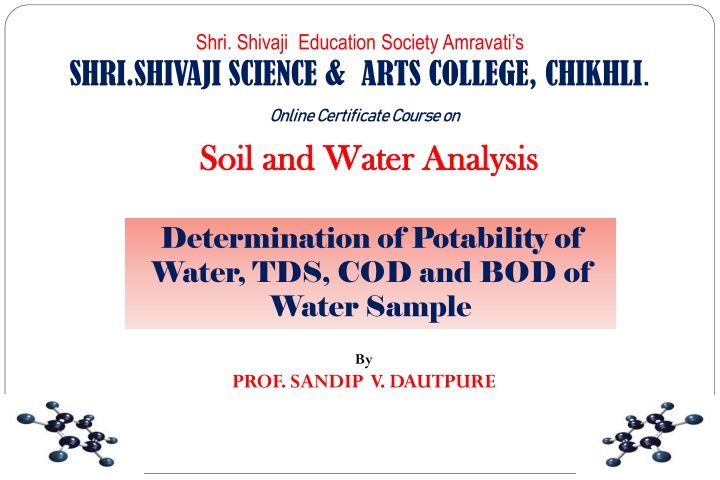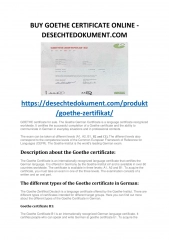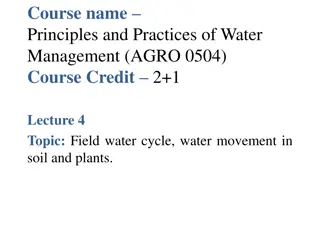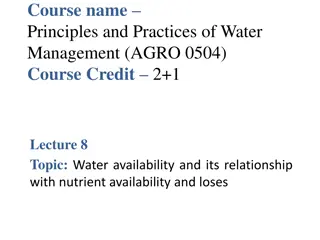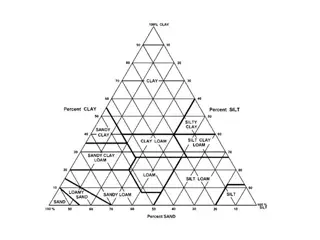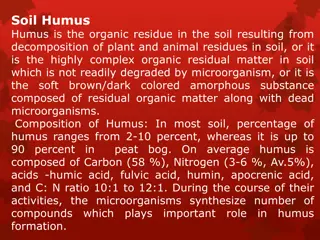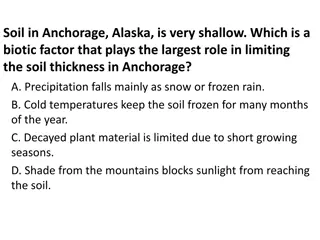Online Certificate Course on Soil and Water Analysis
Learn about water testing parameters, water quality standards, Total Dissolved Solids (TDS), Coliform Bacteria, Reverse Osmosis, BOD, COD, and more. Understand the importance of potable water and its impact on health. Dive into the world of environmental water pollution and ways to determine water quality.
Download Presentation

Please find below an Image/Link to download the presentation.
The content on the website is provided AS IS for your information and personal use only. It may not be sold, licensed, or shared on other websites without obtaining consent from the author.If you encounter any issues during the download, it is possible that the publisher has removed the file from their server.
You are allowed to download the files provided on this website for personal or commercial use, subject to the condition that they are used lawfully. All files are the property of their respective owners.
The content on the website is provided AS IS for your information and personal use only. It may not be sold, licensed, or shared on other websites without obtaining consent from the author.
E N D
Presentation Transcript
Shri. Shivaji Education Society Amravatis SHRI.SHIVAJI SCIENCE & ARTS COLLEGE, CHIKHLI. Online Certificate Course on Soil and Water Analysis Soil and Water Analysis Determination of Potability of Water, TDS, COD and BOD of Water Sample By PROF. SANDIP V. DAUTPURE
CONTENTS Water Testing Parameter Water quality parameters and drinking water standards Total Dissolved Solids (TDS) Otal and Fecal Coliform Bacteria Reverse Osmosis Environmental Water Pollution Parameter Biochemical oxygen demand (BOD) Chemical oxygen demand (COD)
http://iitk.ac.in/iwd/wq/wqpwebpage_files/image008.jpg Swimming in waters with high levels of fecal coliform bacteria increases the chance of developing illness like fever, nausea or stomach cramps from pathogens entering the body through the mouth, nose, ears, or cuts in the skin . Fecal coliform, like other bacteria, can usually be killed by boiling water or by treating it with chlorine. Washing thoroughly with soap after contact with contaminated water can also help prevent infections Diseases and illnesses that can be contracted in water with high fecal coliform counts include typhoid fever, hepatitis, gastroenteritis, dysentery and ear infections.
BIOCHEMICAL OXYGEN DEMAND(BOD) The biochemical oxygen demand (BOD) represents the amount of dissolved oxygen (DO) consumed by biological organisms when they decompose organic matter in water The biochemical oxygen demand (BOD) is also called biological oxygen demand The BOD is a pollution parameter mainly to asses the quality of effluent or wastewater. A BOD level of 1-2 ppm is considered very good. There will not be much organic waste present in the water supply. A water supply with a BOD level of 3-5 ppm is considered moderately clean.
Biological oxygen demand directly affects the amount of dissolved oxygen in rivers and streams. The rate of oxygen consumption is affected by a number of variables: temperature, pH, the presence of certain kinds of microorganisms, and the type of organic and inorganic material in the water. The greater the value, the more rapidly oxygen is depleted in the stream. This means less oxygen is available to higher forms of aquatic life. The consequences of high BOD are the same as those for low dissolved oxygen: aquatic organisms become stressed, suffocate, and die. Sources of biochemical oxygen demand include topsoil, leaves and woody debris; animal manure; effluents from pulp and paper mills, wastewater treatment plants, feedlots, and food-processing plants; failing septic systems; and urban stormwater runoff.
Biological oxygen demand is affected by the same factors that affect dissolved oxygen. Measuring biochemical oxygen demand requires taking two measurements. One is measured immediately for dissolved oxygen (initial), and the second is incubated in the lab for 5 days and then tested for the amount of dissolved oxygen remaining (final). This represents the amount of oxygen consumed by microorganisms to break down the organic matter present in the sample during the incubation period
CHEMICAL OXYGEN DEMAND The chemical oxygen demand (COD) determines the amount of oxygen required for chemical oxidation of organic matter using a strong chemical oxidant, such as, potassium dichromate under reflux conditions. ... The amount of dichromate consumed is proportional to the oxygen required to oxidize the oxidizable organic matter In environmental chemistry, the chemical oxygen demand is an indicative measure of the amount of oxygen that can be consumed by reactions in a measured solution. It is commonly expressed in mass of oxygen consumed over volume of solution which in SI units is milligrams per litre.
A COD test can be used to easily quantify the amount of organics in water. The most common application of COD is in quantifying the amount of oxidizable pollutants found in surface water (e.g.lakes and rivers) or wastewater. COD is useful in terms of water quality by providing a metric to determine the effect an effluent will have on the receiving body, much like biochemical oxygen demand (BOD).
BOD Determination Method BOD Determination Method
Thanks !!! Have a Nice Day
